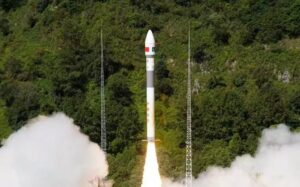India has blazed a spacecraft to the far side of the moon in a follow-up mission four years after a failed effort to land a rover softly on the lunar surface. The mission aims to be the first to land near its little-explored south pole.
Chandrayaan-3 is India’s third lunar exploration mission. If successful, India will be only the fourth country to achieve a soft landing on the Moon, after the United States, China and the former Soviet Union.
Thousands of Indians cheered outside the mission control center as the spacecraft soared into the sky from Satish Dhawan Space Centre.
“Congratulations India. Chandrayaan-3 has started its journey towards the moon,” said the Indian Space Research Organisation (ISRO) director, Sreedhara Panicker Somanath. “Our launch vehicle has put the Chandrayaan on the precise orbit around the Earth,” he said.
LVM3 lifting-off with Chandrayaan-3 pic.twitter.com/XUQY4KHDu9
— ISRO (@isro) July 14, 2023
“Chandrayaan-3 scripts a new chapter in India’s space odyssey. It soars high, elevating the dreams and ambitions of every Indian,” Prime Minister Narendra Modi said in a tweet after the launch.
Chandrayaan-3 explained
Developed by ISRO, Chandrayaan-3 is comprised of a lander, propulsion module and rover. Chandrayaan-3, the Sanskrit word for ‘moon craft’ blasted off from a launch pad on the south-eastern island of Sriharikota.
ISRO director said the main objective of the mission was a safe and soft landing on the moon. Chandrayaan-3, which weighs 3,900kg and cost $75 million, will attempt a touchdown where the lander and rover of ISRO’s Chandrayaan-2 mission were destroyed in a crash in 2020.
The 1,500-kg lander carries the 26kg rover which is named Pragyaan, meaning wisdom. The six-wheeled rover is expected to roam around the rocks and craters on Moon’s surface, gather crucial data and images and send it back to Earth for analysis.
India’s space sector is expected to be worth US$13 billion by 2025. As of April, India has launched 424 satellites for 34 countries, including the United Kingdom, Israel, the United Arab Emirates, Kazakhstan, the Netherlands and Belgium. The ISRO has earned approximately $13 million (1.1 billion Indian rupees) in the past five years from the launch of foreign satellites









